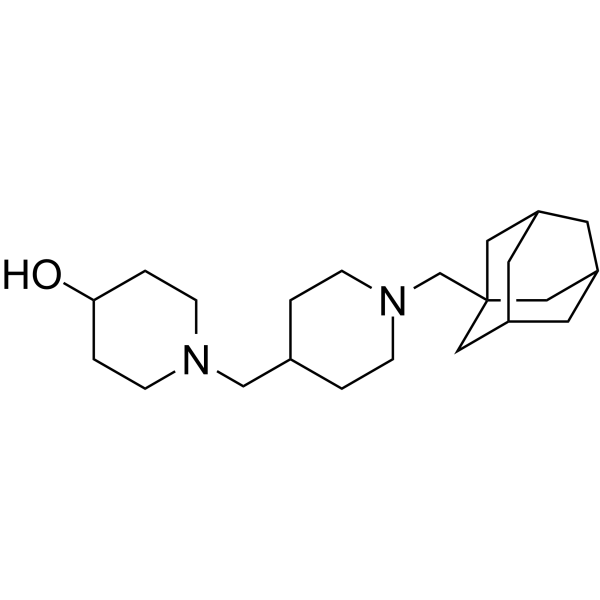Physicochemical Properties
| Molecular Formula | C22H38N2O |
| Molecular Weight | 346.549926280975 |
| Exact Mass | 346.298 |
| CAS # | 627052-25-9 |
| PubChem CID | 9841182 |
| Appearance | Typically exists as solid at room temperature |
| LogP | 3.8 |
| Hydrogen Bond Donor Count | 1 |
| Hydrogen Bond Acceptor Count | 3 |
| Rotatable Bond Count | 4 |
| Heavy Atom Count | 25 |
| Complexity | 421 |
| Defined Atom Stereocenter Count | 0 |
| InChi Key | YUBKDPOCUHUSLW-UHFFFAOYSA-N |
| InChi Code | InChI=1S/C22H38N2O/c25-21-3-7-23(8-4-21)15-17-1-5-24(6-2-17)16-22-12-18-9-19(13-22)11-20(10-18)14-22/h17-21,25H,1-16H2 |
| Chemical Name | 1-[[1-(1-adamantylmethyl)piperidin-4-yl]methyl]piperidin-4-ol |
| HS Tariff Code | 2934.99.9001 |
| Storage |
Powder-20°C 3 years 4°C 2 years In solvent -80°C 6 months -20°C 1 month |
| Shipping Condition | Room temperature (This product is stable at ambient temperature for a few days during ordinary shipping and time spent in Customs) |
Biological Activity
| ln Vitro | SQ609 is toxic to Mtb-infected macrophages and, at 4μg/ml, inhibits more than 90% of intracellular bacterial growth[1]. |
| ln Vivo | In Mtb-infected rats, SQ609 (10 mg/kg; intravenous injection) totally stops weight loss and extends the therapeutic benefit for an additional 10–15 days after drug withdrawal[1]. |
| Animal Protocol |
Animal/Disease Models: TB susceptible mice (C3H/He)[1] Doses: 10 mg/kg Route of Administration: Iv Experimental Results: Prevented weight loss in the Mtb-infected animals and prolonged the therapeutic effect following drug withdrawal for another 10 -15 days. |
| References | [1]. Bogatcheva E, et al. Identification of SQ609 as a lead compound from a library of dipiperidines. Bioorg Med Chem Lett. 2011;21(18):5353-5357. |
Solubility Data
| Solubility (In Vitro) | DMSO : 6.67 mg/mL (19.25 mM) |
| Solubility (In Vivo) |
Solubility in Formulation 1: ≥ 0.67 mg/mL (1.93 mM) (saturation unknown) in 10% DMSO + 90% (20% SBE-β-CD in Saline) (add these co-solvents sequentially from left to right, and one by one), clear solution. For example, if 1 mL of working solution is to be prepared, you can add 100 μL of 6.7 mg/mL clear DMSO stock solution to 900 μL of 20% SBE-β-CD physiological saline solution and mix evenly. Preparation of 20% SBE-β-CD in Saline (4°C,1 week): Dissolve 2 g SBE-β-CD in 10 mL saline to obtain a clear solution. Solubility in Formulation 2: ≥ 0.67 mg/mL (1.93 mM) (saturation unknown) in 10% DMSO + 90% Corn Oil (add these co-solvents sequentially from left to right, and one by one), clear solution. For example, if 1 mL of working solution is to be prepared, you can add 100 μL of 6.7 mg/mL clear DMSO stock solution to 900 μL of corn oil and mix evenly. (Please use freshly prepared in vivo formulations for optimal results.) |
| Preparing Stock Solutions | 1 mg | 5 mg | 10 mg | |
| 1 mM | 2.8856 mL | 14.4279 mL | 28.8559 mL | |
| 5 mM | 0.5771 mL | 2.8856 mL | 5.7712 mL | |
| 10 mM | 0.2886 mL | 1.4428 mL | 2.8856 mL |
